IT Departments Need Proper System Management to be More Efficient and Profitable
IT departments in large enterprises are tasked with responding to numerous business-impacting issues on any given day, including equipment failures, fluctuating website demand, and data security. But putting out these fires leaves little time for proactively managing infrastructure for the future –even something as important as figuring out how much server capacity will be required in the months to come is often put on the back burner. What’s more, while a large majority of IT departments make attempts to plan for the future by using hypothetical questions to model future demand, they’re not necessarily basing decisions off of this practice.
Being unequipped to handle it all and prepare for what’s ahead is a common issue in IT departments across the globe. A new study* by TeamQuest finds a majority of IT departments conducting business in a chaotic IT environment and experiencing cloud outages due to improper management. This is likely why IT managers realize they need to improve their slacking efficiency, mainly by maturing their optimization processes and implementing health and risk management. In fact, many IT managers realize health and risk management has a positive impact not only on efficiency and performance, but on revenue. However, managers in chaotic situations tend to be less likely than those with more mature processes to recognize ways to improve efficiency and to realize that proper health and risk management could be a solution.
IT Fires Soak up Staff Time and Push Planning to the Back Burner
IT managers say their department deals with six unexpected IT issues on average each week. This is one less fire a week (seven) than reported in 2014*. Each of these issues takes an average of three hours and 16 minutes to mitigate, along with eight staff members – which is 11 minutes less (3 hours and 27 minutes) but an additional set of hands (seven) than what was needed in 2014*.
- Managers who say their organization has experienced a cloud outage average eight IT fires a week, while those who haven’t had a cloud outage experience average two.
- Those at companies with 1,000-4,999 employees average taking three-and-a-half hours to mitigate each unexpected IT issue, vs. two hours and 55 minutes for those at organizations with 5,000 or more employees.
IT departments deal with an average of 6 IT fires each week
To mitigate, each fire takes an average of 3 hours and 16 minutes and 8 staff members
This leaves little time to get ahead of issues, which could help ensure cost savings and IT efficiency. IT managers around the globe say that just 10 percent of their staff’s time is spent on proactive improvement activities, such as application tuning, server tuning, data management, and avoiding IT risk.
This is likely why fewer than one in five (17%) IT managers say their organization is able to optimize IT operations via proactive, automated actions – that every solution is embedded with a profound understanding of business goals and their relationship to its online services.
And only 14 percent fall into the “proactive” category on the IT Service Optimization Maturity Assessment. Four times this amount (56%) fall into the “chaotic” category on the maturity scale.
17% of IT managers say their company is able to optimize IT operations via proactive, automated actions
IT Departments Around the World Need an Efficiency Boost
Close to nine in ten (87%) IT managers agree that they are able to measure in real-time how efficient their IT infrastructure is running at any given time.
This on-going insight could be why nearly all (97%) IT managers say the efficiency in their department could be better, which they think could be achieved by actions that include boosting IT optimization (61%), adding or improving diagnosis, trending and/or analytic tools (55%), and improving the company’s reactive processes (54%).
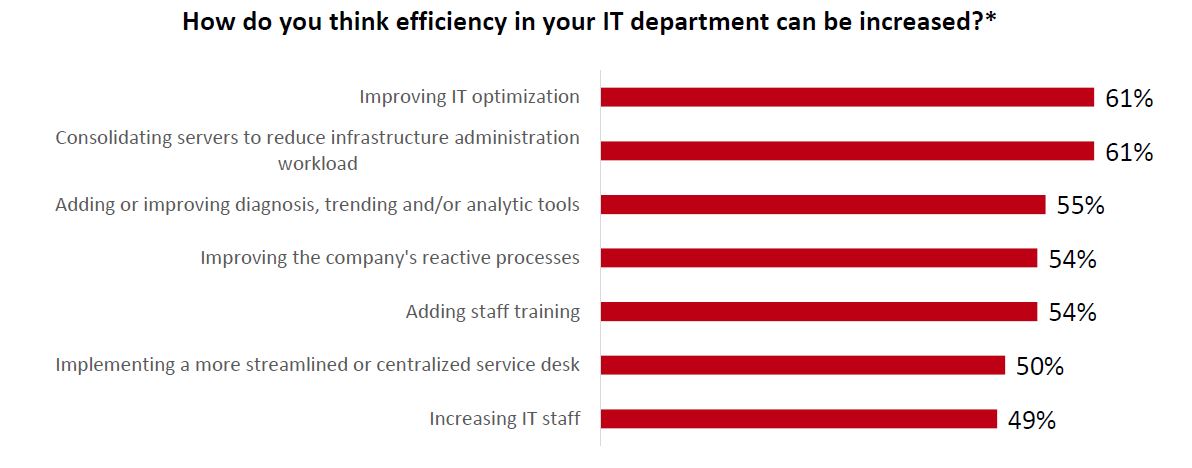
Additionally, nine in ten (90%) managers think efficiency can be improved with proper IT health and risk management.
In fact, those without proper IT health and risk management predict their overall IT efficiency would increase by an average of 25 percent if this management was in place.
Having proper on-premises and cloud management could also help boost efficiency. Managers who lack this type of management think their IT efficiency would increase by an average of 30 percent if they had it.
Most IT Optimization Processes are Not as Mature as They Could Be
Close to three in five (56%) IT managers fall into Level 1 on IT Service Optimization Maturity Assessment, which means they are in an chaotic environment. Just 13 percent are in the highest category, value.
And when ranking how mature their IT optimization processes are, less than one in five (17%) IT managers put their organizations in the most mature bucket.
Far more (36%) rank a four out of five on the self-maturity assessment scale, with five being the most mature. And another 31 percent say they are at the mid-level of maturity.

Majority of IT Departments Experience Cloud Outages Due to Improper Management
Nearly two-thirds (66%) of IT managers report having experienced a cloud outage.
The most common cloud these outages occurred on was private (35%)*.
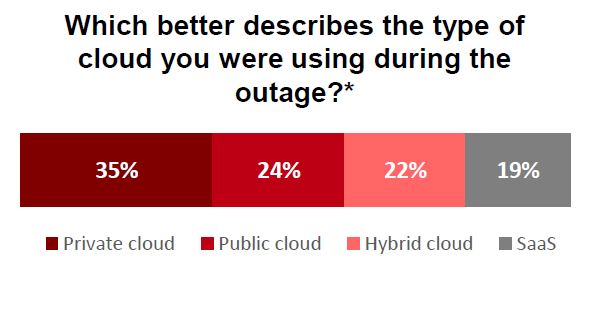
Unfortunately, many cloud outages could have been avoided. Two-thirds (67%) of those who ran into this issue say it was preventable.
There would likely be fewer outages if more companies had better management systems in place. Close to three in five (58%) of those who experienced a cloud outage say it was due to improper IT health and risk management.
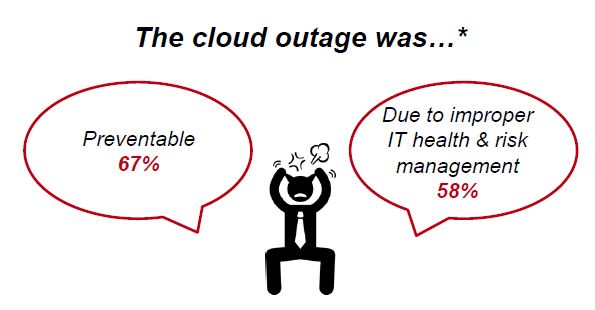
In fact, nearly eight in 10 (79%) IT managers think cloud implementation would improve with proper IT optimization or performance analysis.
However, over four in five (85%) IT managers say their organization doesn’t have proper on-premises and cloud management.
And two-thirds (67%) of managers who don’t have on-premises and cloud management think their IT risk would decrease if they had it.
But even those with on-premises and cloud solutions are not free of issues. Eighty-nine percent have experienced struggles when managing these solutions, including assessing the performance and workload of virtualization applications (62%), comparing the cost effectiveness of different solutions (57%), and resolving performance problems easily (55%).
Being prepared for it could be key. Over nine in ten (92%) IT managers agree that virtual server or cloud management is risky without proper planning.
IT Health and Risk Management Has a Positive Impact on Revenue, Efficiency, and Performance
Nearly all (96%) IT managers who have proper IT health management and optimization have obtained benefits from it.
The top three benefits these managers report seeing are improved IT efficiency (77%), reduced IT outages (64%), and increased workforce productivity (59%).
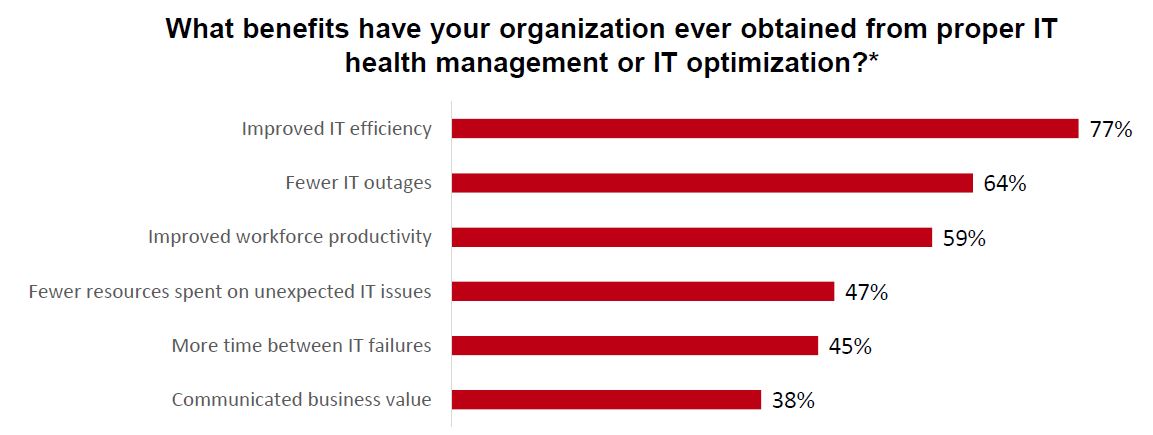
And IT managers believe proper IT health and risk management have a range of benefits. Nearly nine in ten think it would improve workforce productivity (86%), business productivity (86%), and cost savings (85%).
Managers at companies with 1,000-4,999 employees are more likely than those with 5,000 employees or more to think IT health and risk management improves implementing consolidation and virtualization projects (87% vs. 78%) and agility (83% vs. 73%).
And nearly three-quarters (74%) think having proper IT health and risk management would at least somewhat decrease IT risk.
What’s more, over one-third (36%) say the success of their data center is extremely reliant on proper IT health and risk management.
It’s clear that IT health and risk management is crucial, so companies might want to start thinking about updating their systems to bypass competitors. Over two-thirds (68%) of IT managers say their organization is not ahead of the curve when it comes to IT health and risk management.
Thinking Through Hypothetical Scenarios Proves to be Useful for IT Departments
While many IT departments don’t seem to have time to be as proactive as they might like to be, many are trying to prepare for possible issues ahead.
Nearly two in five (36%) IT managers bolster decision making by asking hypothetical questions and conducting various “what-if” scenarios.
In fact, over eight in ten (85%) agree that they’re able to model future demand using “what-if” scenarios.
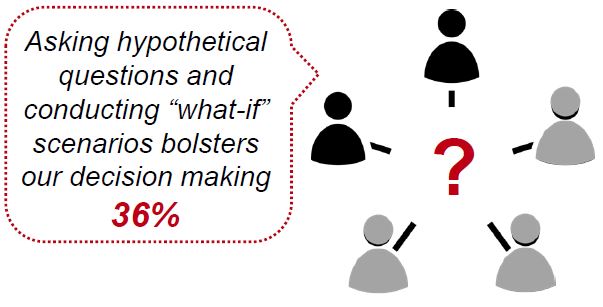

Subgroup Spotlight: IT Optimization Maturity Assessment Levels
Managers in the reactive category and above are more likely than those in chaotic group to realize how to improve efficiency and the benefits of IT health and risk management.
- Managers in reactive category and above are more likely than those in chaotic category (91% vs. 81%) to say they are able to measure how efficient their IT infrastructure is running in real time.
- Those who fall into the reactive category or above on the Maturity Assessment scale and don’t think their department is already performing at optimal efficiency are more likely than those in the chaotic category to say efficiency could be increased by improving IT optimization (68% vs. 55%), adding or improving diagnosis, trending and/or analytic tools (63% vs. 49%), and adding staff training (62% vs. 47%).
- Ninety-four percent of those who fall into the reactive category and above believe their IT efficiency would improve with proper IT health and risk management, vs. 87 percent of those who are in the chaotic group.
- Those who fall into the chaotic category on the Maturity Assessment scale think efficiency would be increased by an average of 27 percent, vs. 22 percent for those in higher categories.
- Nearly nine in ten (89%) of those in the reactive category or above believe proper IT health and risk management would improve cloud implementation, vs. 71 percent of those in the chaotic group.
- Those in the reactive category are more likely than those in the chaotic group to say IT health and risk management can improve IT efficiency (94% vs. 87%), business productivity (92% vs. 81%), cloud implementation (89% vs. 71%), and communications of business value (85% vs. 74%).
- Over two in five (43%) managers in the reactive category and above say the success of a data center is extremely reliant on proper IT risk and health management, vs. 31 percent of those in the chaotic group.
- Seventy percent of managers in the reactive category and above who have seen benefits from proper IT health management or IT optimization noticed improved workforce productivity, vs. 49 percent of those in the chaotic group.
- More than nine in ten (92%) managers in the reactive category and above agree that they are able to model future demand using what-if scenarios, vs. 79 percent of those in chaotic group.
Subgroup Spotlight: Self-Ranking IT Optimization Process Maturity Level
Managers who rank their organization’s IT optimization processes at the top two most mature levels are more likely than those who rank their processes at the mid-to-least mature levels to think better optimization can improve their efficiency and to see the value in proper IT health and risk management.
- Those in the top two maturity groups are more likely than those in bottom three (92% vs. 79%) to say they are able to measure how efficient their IT infrastructure is running in real time.
- It seems IT managers with mature processes are more likely to be aware of improvements that can be made to increase efficiency: Those who rate their organization’s current IT optimization processes in the top two maturity groups are more likely than those in the bottom three maturity groups to think their not-optimal IT efficiency could be improved by bettering their optimization (67% vs. 54%), adding or improving diagnosis, trending and/or analytic tools (61% vs. 48%), adding staff training (59% vs. 48%), and implementing a more streamlined or centralized service desk (59% vs. 41%).
- Over four in 10 (43%) managers in top two mature levels say the success of a data center is extremely reliant on proper IT risk and health management, vs. 29 percent of those in bottom three.
- Those in the top two maturity groups are more likely than those in the mid-to least maturity levels to think IT health and risk management improve cost savings (89% vs. 79%), agility (86% vs. 71%), business productivity (90% vs. 81%), Service Risk Optimization (88% vs. 77%), and communications of business value (86% vs. 71%).
- More than nine in ten (93%) managers in the top two maturity levels say they are able to model future demand using “what-if” scenarios, vs. 75 percent of those in the bottom three maturity levels.
- Those in the top two maturity groups who have seen benefits from having proper IT health management and optimization are more likely than those in the bottom three to report improved IT efficiency (83% vs. 70%), better workforce productivity (67% vs. 49%), decreased resources spent on IT issues (54% vs. 40%), communicated business value (44% vs. 31%).
- However, those who could use the most help realize they are far from ahead of the game. Nearly nine in 10 (88%) of those in bottom three maturity levels say their organization is about average or behind the curve when it comes to IT health and risk management, vs. 51 percent of those in top two.
- And those in the bottom three maturity levels are more likely than those in the top top (80% vs. 68%) to think their overall IT risk would decrease if they had proper IT health and risk management.
About the Survey
The TeamQuest Global Annual IT Management Survey was conducted between January 20th and February 1st, 2016 among 318 IT Managers or Higher in US, UK, Canada, Sweden, France, Germany, Italy, China, Japan and Australia who work in companies with 1,000+ employees, using an e-mail invitation and an online survey.
Results of any sample are subject to sampling variation. The magnitude of the variation is measurable and is affected by the number of interviews and the level of the percentages expressing the results.
In this particular study, the chances are 95 in 100 that a survey result does not vary, plus or minus, by more than 5.5 percentage points from the result that would be obtained if interviews had been conducted with all personas in the universe represented by the sample. The margin of error for any subgroups will be slightly higher.
Kelton Global is a leading global insights firm serving as a partner to more than 100 of the Fortune 500 and thousands of smaller companies and organizations. Utilizing a wide range of customized, innovative research techniques and staff expertise in marketing, branding, PR, media, and business strategy, Kelton helps drive our clients’ businesses forward.
For more information about Kelton Global please call 1.888.8.KELTON or visit www.keltonglobal.com.
Check Your IT Maturity
Take the maturity assessment and find out where your IT organization ranks on the maturity scale. It’s just 20 yes/no questions, and you’ll immediately receive your results and tips on moving to the next level.